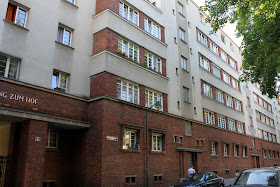According to the very interesting paper, “80 Years of Social Housing in Vienna,” by Wolfgang Förster. Vienna experienced a huge population boom at the end of the nineteenth century when the city grew from 400,000 residents to more than two million. Förster reports the Habsburg Empire offered most of Vienna’s residents “incomprehensible poverty” that wasn’t transformed until the collapse of the monarchy and the start of the Red Vienna movement which built thousands of public housing units, “for the weakest strata of the population in spite of very severe economic conditions, and thereby developed radically new urban qualities.” It seems those urban qualities may have a direct correlation to Vienna’s current status as one of the best places to live on the planet.
Monday, July 23, 2012
The Surprising Rabenhof Public Housing
Vienna is a fairly compact city and with about 80% of its residents renting, the city is filled with apartments. All over Vienna you'll find public housing projects. I finally went exploring in one called Rabenhof, close to where the photos in my last post were taken, and, once inside the perimeter, was astounded to see how nice it is. Inside architects Heinrich Schmidt and Hermann Aichinger designed very comfortable spaces, stylish art deco architecture, parks, gardens, playgrounds, seating areas, laundry areas, a cool theater, and a kindergarten.
According to the very interesting paper, “80 Years of Social Housing in Vienna,” by Wolfgang Förster. Vienna experienced a huge population boom at the end of the nineteenth century when the city grew from 400,000 residents to more than two million. Förster reports the Habsburg Empire offered most of Vienna’s residents “incomprehensible poverty” that wasn’t transformed until the collapse of the monarchy and the start of the Red Vienna movement which built thousands of public housing units, “for the weakest strata of the population in spite of very severe economic conditions, and thereby developed radically new urban qualities.” It seems those urban qualities may have a direct correlation to Vienna’s current status as one of the best places to live on the planet.
According to the very interesting paper, “80 Years of Social Housing in Vienna,” by Wolfgang Förster. Vienna experienced a huge population boom at the end of the nineteenth century when the city grew from 400,000 residents to more than two million. Förster reports the Habsburg Empire offered most of Vienna’s residents “incomprehensible poverty” that wasn’t transformed until the collapse of the monarchy and the start of the Red Vienna movement which built thousands of public housing units, “for the weakest strata of the population in spite of very severe economic conditions, and thereby developed radically new urban qualities.” It seems those urban qualities may have a direct correlation to Vienna’s current status as one of the best places to live on the planet.


















I found this post very interesting. My mother grew up in Vienna and my aunts and uncles still live in these types of residences, as well as all having built small homes in the outskirts of Vienna as weekend retreats/holiday homes. I remember visiting Vienna as a young girl and then again at 16 and yes, you are right, they are lovely. But what impressed me most about your photos is that although it is public housing in Vienna the streets and parks are so clean, no litter and because these homes stay in the family for as long they have someone to pass it on to, the people of Vienna care for the public housing as if it was their own. Sadly this is not the case in some other western lands. Very impressive. Thanks for sharing. Although I don't always comment, I always read your blog and love to see your beautiful photos.
ReplyDeleteThanks so much for adding your knowledge to this post. I didn't know these flats could be inherited...guess that means it is unlikely we could ever live there. I also don't know if foreigners are allowed to live in public housing. We did visit another housing project last night, Karl Marx Hof. It was huge and not nearly as comfortable in terms of use of space. Rabenhof had some brilliant architects and planners. I feel positively drawn to Rabenhof and want to see it again and perhaps talk to some of the residents. Thanks again for your comments.
DeleteWe have seen apartment prices increase dramatically in Vienna during the past eight years. It seems societies are not going in the right direction when property belongs primarily to corporations and the very wealthy and ordinary people are priced out of the housing market. Thanks for your comment; wish we could discuss further.
ReplyDelete